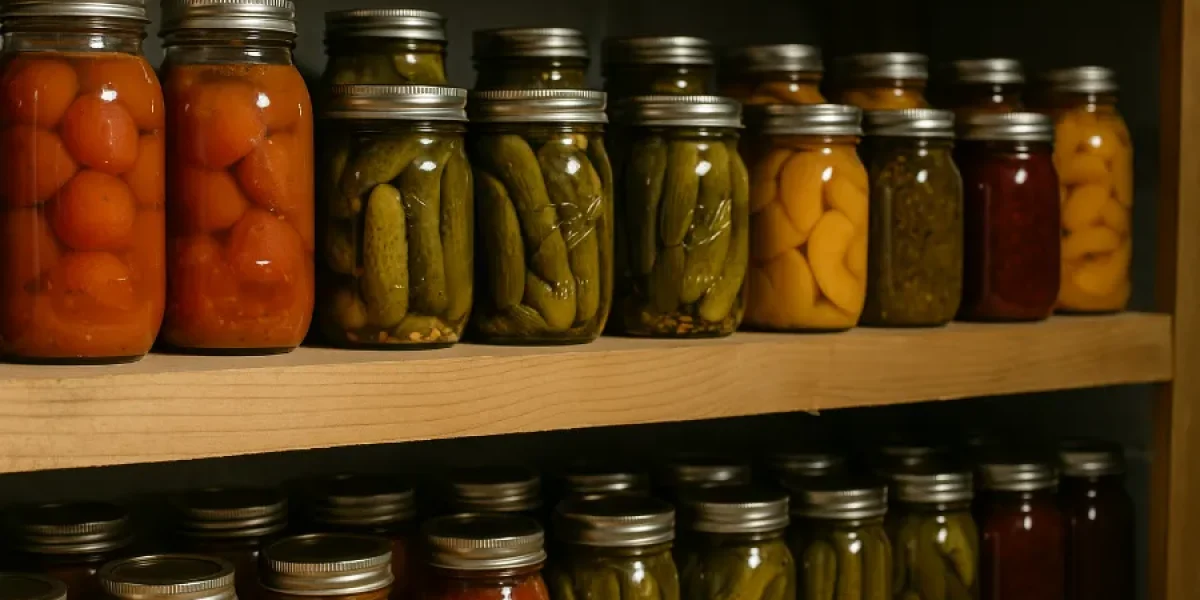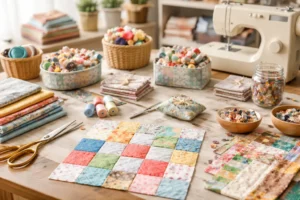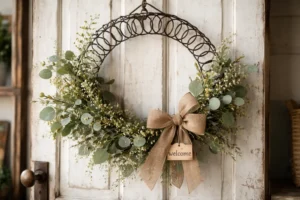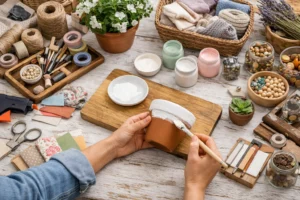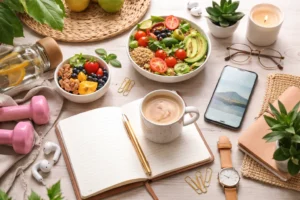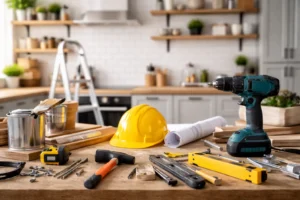Every summer, when the kitchen fills with the sound of bubbling pots and the scent of vinegar, herbs, and fruit, I think about one thing: safe storage.
After hours of canning wiping rims, hearing those satisfying lid “pops,” and lining jars up like soldiers — I remind myself that the real preservation work continues after processing. How we store our canned goods is what truly determines their shelf life and safety.
Over the years, I’ve learned (sometimes the hard way) that proper food storage is just as important as the canning itself. So today, I’m walking you through my personal methods, old and new, for keeping every jar as safe and delicious as the day it was sealed.
Canned Food: The Reward of a Well-Stocked Pantry
There’s something deeply satisfying about seeing rows of canned food — tomato sauce, pickles, jams, and even pressure-canned soups — lined up and ready for the year ahead. It’s security in glass form.
But canned food isn’t indestructible. Even after perfect processing, exposure to heat, light, or moisture can break seals or dull flavors. That’s why I treat my storage area like an extension of the canning process — a place that demands care, consistency, and attention.
When you practice safe storage, you’re not just saving food; you’re preserving time, effort, and a little bit of your homesteading pride.
Canned Goods: Understanding the Enemies of Longevity
Your canned goods are more delicate than they look. The three biggest threats to their long-term health are light, heat, and moisture.
- Light fades colors and breaks down nutrients.
- Heat weakens seals and shortens shelf life.
- Moisture encourages rust and mold growth.
Even if your jars look fine, poor storage can quietly compromise them. That’s why safe storage isn’t just about neat shelves — it’s about protecting your food from everything that shortens its life span.
Food Storage: The Three Golden Rules
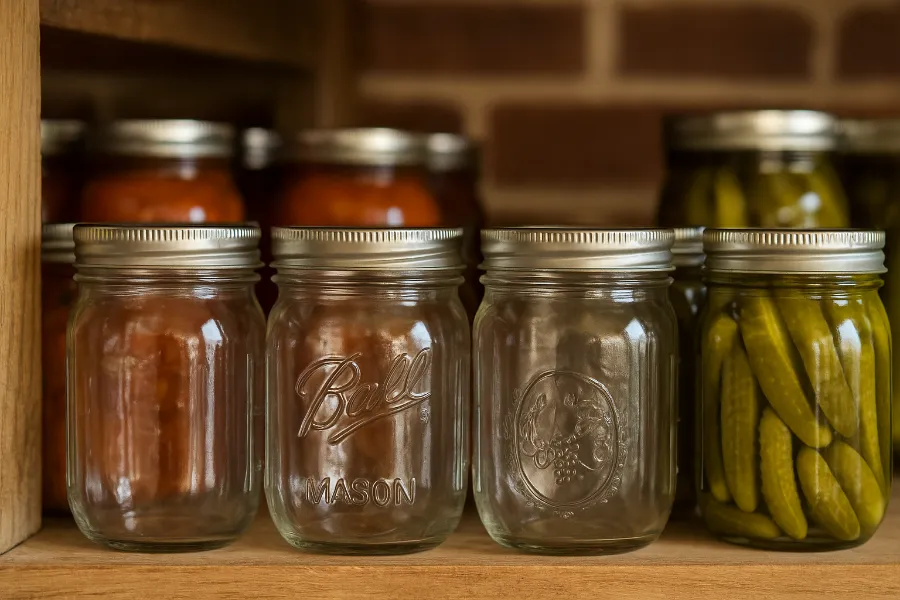
When I talk to new canners about food storage, I always come back to the same three rules: keep it cool, dark, and dry. These are the foundation of safe storage.
- Cool — Ideal temperature is between 50°F and 70°F. Too hot, and food deteriorates faster; too cold, and jars can crack.
- Dark — Keep jars away from direct sunlight or bright light. Darkness preserves color and nutrition.
- Dry — Moisture is the silent enemy. It rusts lids, loosens seals, and can lead to contamination.
Even if your jars are sealed perfectly, breaking one of these rules can lead to spoilage.
Shelf Life: How Long Do Home-Canned Foods Really Last?
If there’s one thing people always ask me, it’s, “How long will my canned food last?”
Under the right conditions, most home-canned foods maintain quality for 12 to 18 months. After that, they may still be safe, but taste and color begin to fade.
Here’s my general guide to shelf life based on years of canning (and tasting):
| Food Type | Good Quality For | Still Edible (if stored safely) |
|---|---|---|
| Pickles & Relishes | 1–1.5 years | 2 years |
| Jams & Jellies | 1 year | 2 years |
| Tomatoes & Sauces | 1.5 years | 3 years |
| Pressure-Canned Meats | 1.5 years | Up to 5 years |
| Fruits in Syrup | 1 year | 2 years |
Labels and rotation are your friends. I mark every jar with the date and stack newer batches in the back. That way, nothing gets forgotten.
Pantry Storage: My Everyday System
My main canning stash lives in my pantry tucked into a shaded corner far from the oven or dishwasher. Pantry storage is convenient, but it still requires planning.
Here’s what’s worked best for me:
- Use solid, sturdy shelving. Canned food is heavy. Weak shelves will sag or even collapse.
- Keep away from heat sources. Avoid walls near heating ducts or appliances.
- Line shelves with paper or rubber mats. This prevents jars from sliding or sticking.
- Remove screw bands. Once jars seal, take off the rings to prevent rust and false seals.
- Rotate stock. Always use the oldest jars first.
With these habits, my pantry has stayed organized and my food has stayed vibrant — even after years of canning.
Preserving Food: The Long Game
Canning isn’t just about filling jars — it’s about preserving food for seasons ahead. Whether it’s jam from summer berries or stew from your fall harvest, storage plays a critical role in maintaining that fresh, homemade flavor.
The longer food sits, the more it slowly changes. Colors may fade, and textures may soften, but with safe storage, those changes happen gracefully.
To preserve food well:
- Label every jar clearly.
- Check seals periodically.
- Discard anything that smells off or leaks.
- Store jars upright to maintain pressure and prevent leaks.
Preserving food is as much about patience and care as it is about recipes and timing.
Root Cellar: The Old-Fashioned Way Still Wins
I grew up hearing stories of my grandmother’s root cellar dark, cool, and lined with shelves full of canned peaches, beets, and pickles. When I finally built my own, I understood why it’s still considered the gold standard for safe storage.
Root cellars naturally maintain the perfect environment for canned goods:
- Cool, consistent temperatures around 50–60°F
- Low light
- Balanced humidity
If you’re lucky enough to have one, use wooden shelving (metal can rust) and keep jars off the ground. Leave a few inches between shelves and jars to encourage airflow.
Even if your “root cellar” is just a cool basement corner, it’s worth it. It’s nature’s version of a climate-controlled pantry.
Food Safety: Mistakes I’ll Never Make Again
Canning teaches humility. Every seasoned canner has a story about a batch gone wrong — mine involves an entire row of spoiled peaches that taught me everything I know about food safety.
Here’s what I learned to avoid:
- Never store jars in sunlight — it bleaches and weakens seals.
- Don’t keep them in humid spaces — moisture means rust.
- Don’t ignore bulging lids or leaks — those are warning signs.
- Don’t leave rings on sealed jars — they trap moisture.
Food safety doesn’t end when the canner is turned off. It’s a year-round commitment to care and observation.
Temperature Control: The Secret Ingredient for Longevity
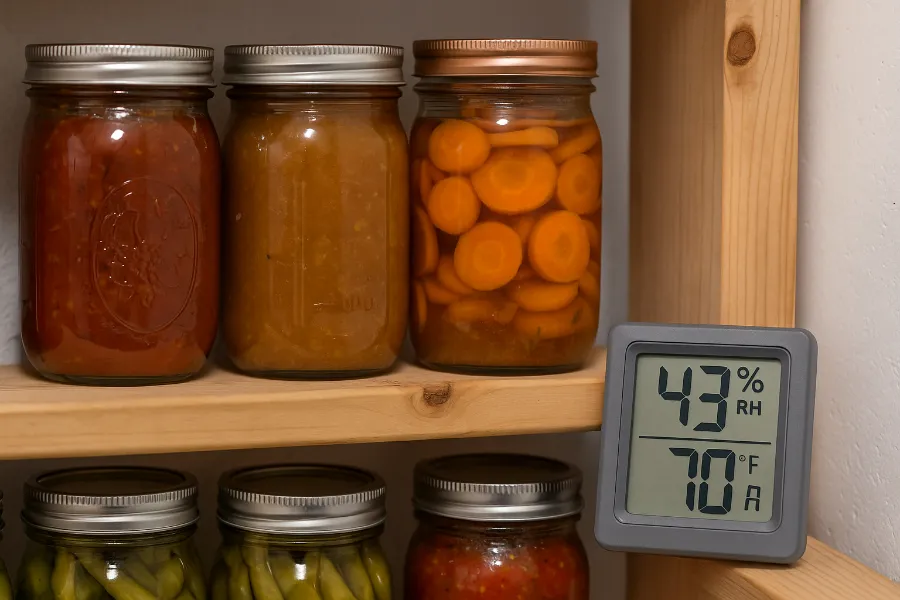
The right temperature control makes all the difference between jars that last a year and jars that last five.
I aim for 50–70°F year-round. That’s not always easy — especially in summer — but consistent temperature keeps the vacuum seal intact and the contents stable.
Avoid storing jars near:
- Windows
- Water heaters
- Stoves
- Laundry appliances
If your home tends to run warm, a dehumidifier or small fan in your pantry can help stabilize both heat and moisture.
Mason Jars: The Heart of Home Canning
Every time I hold a mason jar, I’m reminded of why I love canning — it’s timeless, durable, and personal. These jars have been around for over a century for good reason: they’re reliable and reusable.
But even mason jars need care. Here’s how I keep mine in good shape:
- Check for chips or cracks before each use.
- Wash thoroughly and air-dry before refilling.
- Store empty jars upright and covered to keep dust out.
- Never stack full jars directly on top of one another without padding.
A clean, undamaged jar is the foundation of safe storage.
Humidity Control: The Hidden Factor
You can have perfect temperature and darkness, but if humidity is off, your jars can still suffer. Rusted lids, moldy labels, and musty odors all point to poor humidity control.
I keep a small digital humidity gauge in my storage area, aiming for around 40%. In the damp months, I use moisture absorbers or a dehumidifier.
If you notice condensation on jars or shelves, it’s time to adjust the airflow. Small tweaks like these can prevent major spoilage later.
Pressure Canning: Extra Care for Low-Acid Foods
Pressure canning is essential for low-acid foods like meats, soups, and beans — but these jars need a little more attention after processing. Because proteins and fats are sensitive to heat, safe storage becomes even more important.
Store pressure-canned items in the coolest, darkest area you can find — ideally between 50°F and 60°F. Label them clearly, and aim to use them within two to three years for best quality.
Even though properly stored jars can last longer, freshness fades over time. I like to think of pressure-canned food as “pantry gold” — valuable and worth guarding carefully.
My Routine for Safe Storage
Here’s my step-by-step post-canning routine:
- Let jars cool completely for 12–24 hours.
- Remove rings and check seals.
- Wash jars and lids gently to remove residue.
- Label with content and date.
- Store in a cool, dark, dry location.
- Rotate and inspect every few months.
It takes only a few minutes, but it keeps every jar safe and traceable.
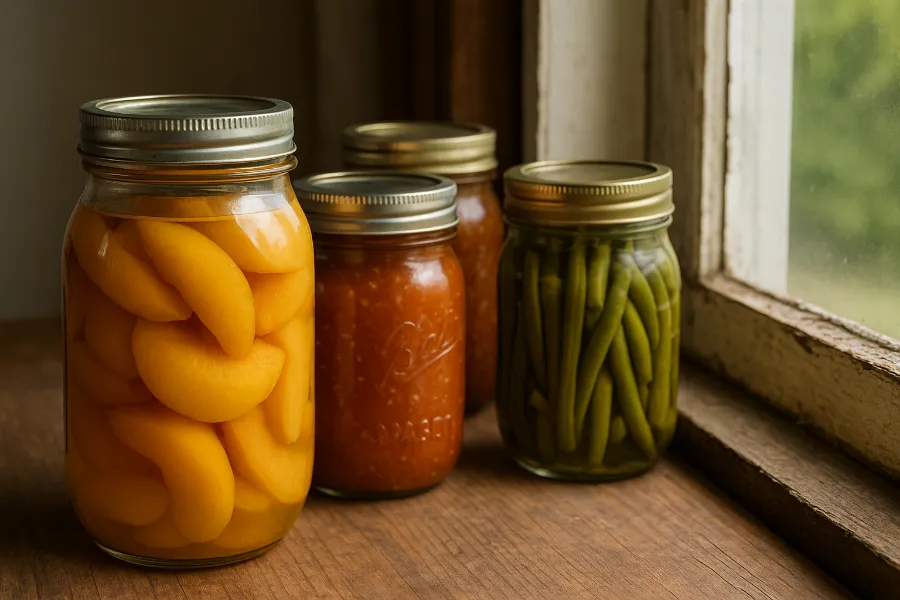
Why Safe Storage Is Worth the Effort
Practicing safe storage means peace of mind. It means opening a jar in January and tasting summer. It means no wasted effort, no spoiled food, and no regrets.
Whether your jars live in a pantry, root cellar, or temperature-controlled closet, the principles remain the same:
- Keep them cool, dark, and dry.
- Check seals often.
- Label and rotate.
Canning connects us to generations before us — those who knew the value of a well-kept pantry and a dependable food supply. When you commit to safe storage, you’re continuing that tradition — one shining jar at a time.
FAQs
Store jars in a cool, dark, and dry place between 50°F and 70°F. Keep them away from direct sunlight, heat sources, and humidity to maintain seals and quality.
Most canned goods maintain top quality for 12 to 18 months, though many stay safe longer if stored properly. Always check seals and labels before using.
It’s best to avoid garages or sheds since they experience temperature fluctuations and moisture. Choose a stable indoor area instead, like a pantry or basement.
Yes. Once jars are sealed and cooled, remove the screw bands. This prevents rust and moisture from collecting under the rings, which could compromise seals.
Aim for moderate humidity, around 35–50%. Too much moisture can rust lids, while overly dry air can weaken seals.
Yes, but they benefit from slightly cooler conditions. Pressure-canned meats and soups last longer when kept in the lowest, most stable temperature zones.
Discard any jars with bulging lids, leaks, or off smells. When in doubt, never taste questionable canned food safety always comes first.

